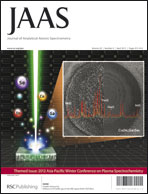Atomic spectrometry update. Clinical and biological materials, foods and beverages
Abstract
This update is a little shorter than in recent years, reflecting the fewer original papers published. However, the trend for a large number of review articles has continued and these cover a wide range of important topics. In the 2012 update, a noticeable increase in work involving very small samples was evident. These observations continue through into the current review. This was particularly seen with sample introduction systems used for ICP-MS. A microflow device for aerosol generation, based on thermal inkjet technology, provided for analysis of highly dissolved solids at a flow rate of 1 μL min−1 while other high performance arrangements were described which operated at slightly larger delivery rates. As in previous years, major topics include investigations of the metabolism of As and Se. We have also previously reported on the techniques to measure Pt–DNA adducts, developed in the last few years. It is encouraging to see that these are now being applied to studies of platinum anti-cancer treatments in cell cultures and in patients. There are some interesting new methodologies. Quantum dots appeared for the first time in this review with an indirect assay for measuring very low concentrations of protein in urine. A protein conjugate formed with CdTe quantum dots was isolated and the Cd measured by ICP-MS. XRF has poor sensitivity for low atomic number elements but in another indirect assay, Li in mineral water was determined by forming a potassium lithium periodatoferrate complex and measuring the Fe. Magnetic particles are used in some immunoassays to effect separation of reagents and a similar approach was developed using Fe3O4 magnetite nanoparticles modified with 1-(p-acetyl)phenyl)-3-(o-ethoxyphenyl)triazene to extract and preconcentrate Hg from water and fish samples. Concern over the amount of As in fish and rice and the potential for this element to appear in other food products is evident from studies involving fish oils and organic brown rice syrup. Anyone tempted to eat alligator meat can be reassured that concentrations of Cd, and Pb are very low. We are pleased to have a new contributor to this review; Sarah Hill has considerable experience with ICP-MS techniques including the use of this technique for imaging.

- This article is part of the themed collection: Atomic Spectrometry Updates

 Please wait while we load your content...
Please wait while we load your content...